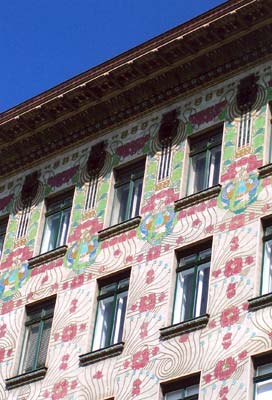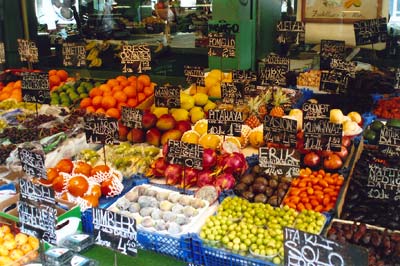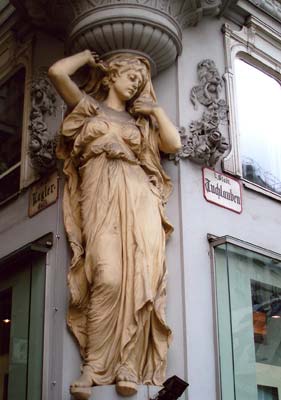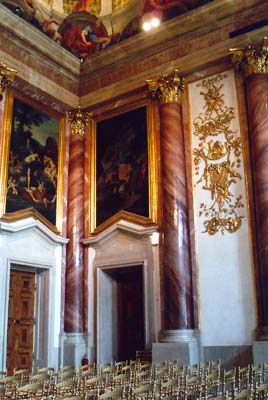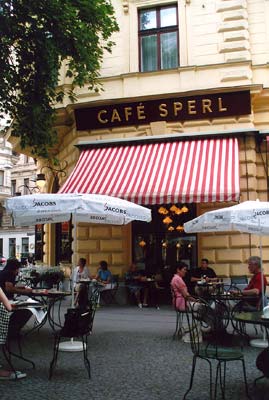An in-depth look at Vienna
by Marilyn Lutzker, Sunnyside, NY
Vienna is an urban delight. It is a majestic and opulent city for lovers of art, architecture, music, coffee and pastry.
Everywhere I went in this outdoor museum, something enticed me to look more closely. The city’s Baroque past was everywhere. Men and women of stone and marble stared out from doorways of elaborately ornamented buildings while carved faces peered down from amongst the swirls and curves above their windows. The statues that couldn’t fit at eye level adorned the parapets — a veritable army of warriors, saints and historic figures living at the rooflines.
Scattered throughout this Baroque extravaganza are works of the Secessionists, architects and designers of the turn of the 20th century who developed the Austrian version of an artistic style inspired by elements of Art Nouveau and the Arts and Crafts movement. Their buildings are simpler, more elegant and more colorful than the ornate structures which surround them. This diversity is one reason that UNESCO has declared the historic center of Vienna a World Heritage Site.
The glory of Vienna is that within this architectural splendor there is a vibrant, lively city.
I strolled along bustling pedestrian avenues lined with high-end shops and equally thriving neighborhood shopping streets catering to all tastes. I was constantly tempted throughout the city by restaurants and cafés. There were so many cafés with so many people sitting at tables on every possible piece of sidewalk or garden that I wondered if anyone in this city went to work.
Seeing the sights
Making a complete circle around Vienna’s historic city center is one of the biggest and most beautiful boulevards in Europe. The 2½-mile circumference of the Ringstrasse is a particular delight for visitors because it passes so many of the city’s cultural institutions.
Trams No. 1 and 2 run every few minutes in a continuous circle around the Ringstrasse, passing directly in front of the Art History Museum, the Natural History Museum, the Decorative Arts Museum, the Opera House, the National Theater, the Parliament building and several parks. It takes about 30 minutes to make the complete circle.
Several times when my feet needed a rest, I got on the tram and rode around the entire ring, enjoying the sights from the windows.
Pride of place amongst the institutions along the Ringstrasse goes to, in my mind, the Kunsthistorisches Museum (Art History Museum). The imperial pomp and grandeur of this building overwhelm me every time I enter it. Majestic spaces, elaborate staircases, gold-encrusted stucco work and lusciously colored frescoes surrounded by a dozen varieties of marble panels, pilasters and columns are an appropriate introduction to rooms full of paintings that include works by Breugel, Botticelli, Rembrandt, Cranach, Hieronymus Bosch and Rubens.
Although it looks and feels like a palace, this museum is one of the greatest purpose-built museums in the world. Constructed in the 1880s with unlimited funds to glorify the collections of generations of Hapsburg emperors, the building and the works it houses rank with the British Museum and the Louvre.
Although the place is huge enough to guarantee museum feet if you try to see it all in a single visit, really comfortable sofas in the large painting galleries provide welcome relief. The café is good for a light lunch or not-so-light afternoon coffee and cake (except on Sunday, when only an expensive price-fixed brunch menu is available, at €47 per person).
The Gemäldegalerie
If you find the size and opulence of the Kunsthistorische Museum overwhelming, or you have time for only a few old masters, visit the Gemäldegalerie at the Akademie der bildenden Künste (Academy of Fine Arts). Situated on the top floor of a functioning art school with chipped plaster decorations, creaking wooden floors, and walls which look as if they haven’t been repainted since the building was constructed early in the last century, the Gemäldegalerie is one of Vienna’s hidden gems.
Not all of the 300 paintings which make up this collection are world-famous masterpieces, but I found enough works by Rembrandt, Ruisdael, Bouts and Cranach the Elder to sate my longing for great paintings for one day. The highlight of the collection is Hieronymus Bosch’s “Last Judgment.”
When I visited this gallery in 2006 I had it entirely to myself; on my May ’07 visit I went on a rainy Sunday afternoon and had to share these masterpieces with perhaps 10 other people.
When your eyes have had enough fine art, it’s time for the world-famous Naschmarkt, an outdoor market located near the Gemäldegalerie.
Naschmarkt
Six varieties of asparagus, five types of potatoes and six kinds of tomatoes — my favorite stand in the Naschmarkt rendered decision making difficult. Fortunately, I had decided not to buy lettuce; the next stall had 12 kinds of salad greens!
The Naschmarkt is a Viennese institution dating back to the 16th century. More than half a mile long with three rows of booths, this open-air market has room for breads, pastries, olives, cheese, meat, spices, ready-to-eat Middle Eastern specialties and every type of vegetable that Italian grocers could possibly stuff, plus fresh fruit and vegetables. On most visitors’ agendas and a photographer’s delight, it makes for a pleasant, leisurely stroll on weekdays. On Saturdays, by midday it sometimes feels as if every tour bus and every shopper in Vienna has landed there.
My preferred fast lunch while browsing the market is pickled herring on a roll. You might prefer a roll with schnitzel, or perhaps lamb or falafel on pita (each costs less than $4). For a full meal, there are restaurants featuring Viennese, Thai and Japanese food.
The market is open from 6 a.m. to 6:30 p.m., Monday-Saturday. Some restaurants are open later.
The flea market
With its mounds of used clothes on one side and silver and fine porcelain on the other, I think of Vienna’s weekly Saturday flea market as either the world’s junk bin or the accumulation from the attics of hundreds of grandmothers.
I paid careful attention to each table as I moved between serious collectors and aimless browsers out to enjoy the sunny day and perhaps find that perfect bargain. Don’t expect to find a priceless 19th-century treasure for 5 euros; more likely, you will buy an odd piece of old lace for 5, a brass picture frame for 20, an intriguing piece of old hardware for 10 or perhaps a 1930s deco-style vase or bowl for 200.
Bargaining is part of the deal; offer half the asking price and go from there. Go early to avoid the crowds and the sun.
The flea market begins at the end of the Naschmarkt. If you are in Vienna for only a brief time, you may choose to visit both in the same day, but if you really enjoy a good flea market the combination might be too much.
Art and animals
In this city there is always another museum and it’s easy to overlook the lesser-known ones.
Away from the center but easily accessible from Tram D, the Liechtenstein Museum is a treasure of Baroque art, architecture and gardens. The princes of Liechtenstein have collected art for centuries, and early in the 18th century they had a palace and garden built for themselves in Vienna. In the 1960s, the family turned that palace into a museum for their masterpieces.
In an eye-boggling Baroque hall (the largest in Vienna), a performance of Baroque music is a rare treat which you can enjoy if you visit the Liechtenstein on a Sunday. There is no additional charge for the one-hour concert (2-3 p.m.), but performances are not given in July and August.
Giant pandas voraciously chomping on bamboo shoots made for a pleasant afternoon change from concrete, marble and old masters. Amongst tree-shaded paths and architectural reminders that the Vienna Zoo is over 250 years old, I relaxed in front of the expected elephants, gorillas, monkeys and giraffes. However, I did not expect the colony of king penguins or those giant pandas, each of which “agreed” to pose prettily for photographs.
Reputed to be the world’s oldest zoo, the Tiergarten is tucked away in one small corner of Schönbrunn Park, site of the 1,441-room Schönbrunn Palace. (If you haven’t had enough Baroque interiors, you can take a tour of part of the palace.)
KunstHaus Wien
Vienna also has room for the eccentric. I am always surprised each time I turn the corner and see the KunstHaus Wien. I have to suppress a laugh as I look at the fancifully shaped columns in front of the entrance and the abstract arrangement of black and white tiles and irregularly shaped windows on its oddly bulging façade. This place is truly quirky.
A former factory, the building has been transformed into a museum and repository for the drawings, paintings and architectural models of Friedensreich Hundertwasser (1928-2000), and there is nothing else like it in the world. Inside, in accordance with Hundertwasser’s philosophy that nothing in nature is truly straight, there are undulating floors and very little that is truly perpendicular or parallel.
Brilliant colors and whimsical shapes characterize Hundertwasser’s style. His paintings are vibrant and frequently playful, and his architectural models are imaginative. Some would characterize both as eccentric.
The museum always has a special exhibition in addition to displaying works of the master. If you go, plan on lunch in the café, whose decor continues the playful theme of the building. Each table is different, the floor is uneven and there are trees in unexpected places. And don’t miss the bathrooms! They are a bit out of the way but are among my favorite places.
The Museum Quarter
The MuseumsQuartier (Museum Quarter) is a superb example of architectural adaptation. The buildings and courtyards which were built by 18th-century Hapsburgs for their horses have been transformed into one of the largest cultural complexes in the world.
The apricot-colored buildings of the original stables now serve as workshops and exhibition space for more than 40 different cultural organizations.
On a sunny day the quarter becomes the scene of a big party. Cafés and park benches border the old buildings, and adults and children sit in and on the odd-looking fiberglass structures that fill the center. It’s like a park without grass.
Sitting a bit awkwardly at either end of this Baroque courtyard are two art museums, either one of which should be a destination on its own. It’s possible for those with strong feet and stronger eyes to visit both in the same afternoon; I never managed it.
The Leopold Museum is devoted to the masterpieces of the Vienna Secession and Austrian Expressionists. With the world’s largest collection of works by Egon Schiele and important works by Gustav Klimt, Oskar Kokoschka and other notable representatives of Austrian art from the late 19th and early 20th centuries, the Leopold is one of the major attractions of Vienna.
The Museum of Modern Art/Ludwig Collection (MUMOK) contains a collection of classic modern art, ranging from Picasso to Warhol. One of the joys of my visits to Vienna is that, despite the quality of the collections in these museums, I have never found them crowded.
Vienna’s art scene is not all old masters or masterpieces of the last century. Kunsthalle Wien, situated within the old stables, is a major venue for contemporary art, photography and multimedia installations.
A night out
Vienna is heaven for music lovers. There are operas, symphonies and chamber music every evening. Offerings range from “tourist shows” featuring brief excerpts of familiar works to serious but lesser-known groups, not to mention Vienna’s world-famous companies.
If you are interested in the latter, buy your tickets online as early as you can; seats not taken by subscribers sell out quickly. We had no trouble getting tickets for superb performances by some lesser-known groups.
Be alert to performance times. Many concerts start at 7 p.m.
Vienna is full of good restaurants, with enough variety (Balkan, Greek, Italian, Thai, Japanese) for every taste and budget. We had many delightful meals at modest establishments and usually spent between $12 and $20 each for a main dish and wine.
Prices listed on menus always include tax and usually a tip. When a tip is included, it’s customary to “round up,” adding an additional 5%-10%. In cafés and bars, prices seemed more uniform. Expect to pay $3-$4 for a small beer (there appear to be no bad beers in Vienna) and $3-$5 for cake (there are no bad cakes, either). There are many varieties of coffee, most about the same price as the cake. There were days when our afternoon cappuccino and sachertorte cost as much as our dinner.
For the best sachertorte in Vienna, go to Café Sperl (11, Gumpendorferstrasse); take Girardigasse north from the Naschmarkt to the corner of Gumpendorferstrasse. This historic café has old-world elegance and a ban on cell phones.
Restaurant recommendations
Zum Sopherl am Naschmarkt (Linke Wienzeile, 34), across the street from the Naschmarkt, is a traditional Viennese Beisl, with dark wood, a mural painted on the back wall, and locals drinking beer in the front. Service is pleasant, and the food is as tasty as it is plentiful.
My favorites are Eiernockerl, a traditional dish of small dumplings, scrambled eggs and fried onions (about $8 for a serving that would do easily for two people), and goulash, the small order of which is sufficient for one (about $4). Do not resist the temptation to use the bread to sop up the gravy!
Even though the sign on the outside of Hansen (Wipplingerstr. 34), in the cellar of the Börsegebäude (Vienna Stock Exchange), indicated we were in the correct place, I kept thinking there was something wrong as we walked through aisles of flowers, plants and garden sculpture, but it all made sense when I discovered that Hansen is situated in one corner of a large garden supply store.
We went for a late breakfast of orange juice, French toast, bacon and cappuccino, which cost $20 for two. Typical for Vienna, the French toast and the cappuccino were the same price.
One block from the Naschmarkt is Crossover Café (Schleifmühlgasse 16/A). In this land of schnitzel and goulash, it was nice to find a comfortable nontouristy café/restaurant that included lighter fare and many vegetarian dishes. We had many meals here and they all were good. Main dishes and drinks for two averaged $20-$30. Crossover is open Sundays and they have menus in English.
If you can’t resist good ice cream, don’t miss Eissalon am Schwedenplatz, conveniently located directly on tram routes 1 and 2 at Schwedenplatz. The menu depicts in luscious color at least 60 ways in which their 18 ice cream flavors can be combined with syrups, garnishes, whipped cream and fruit.
I resisted the banana split and the half pineapple filled with ice cream, assorted fruits, syrups and whipped cream ($7) and opted for three unadorned scoops of ice cream ($4). You can also choose from a variety of cones if you don’t want to sit down, and there are some sugar-free options.
So much more
It’s frustrating not to be able to describe more of Vienna. Here are a few additional places to consider, if you have the time: the Belevedere Palace, with the world’s largest collection of Klimt paintings in a Baroque palace to rival the best of them; the Naturhistorisches Museum (Natural History Museum), housed in a building which mirrors the Kunsthistorische Museum, which it faces; the Museum of Applied Arts (MAK), with unparalleled collections of Art Deco glass and silver; the Albertina, with one of the world’s greatest collections of graphic arts, and the specialized museums within the imperial Hofburg complex.
Getting around
It is easy to get around in Vienna. The U-bahn is clean, mostly air-conditioned and fast. Their map is a model of clarity, electronic signs tell you when the next train is due, and every station seems to have access by escalator or elevator.
Buses and trams are equally convenient. Stations are clearly marked and each has either an electronic sign or a posted schedule of arrival times. Amazingly (at least to a New Yorker), buses and trams always come on time.
The city is comfortable also for the mobility challenged. In addition to elevators and escalators in the U-bahn, there are curb cuts, traffic lights which provide enough time to cross, a driving code that appears to mandate that cars stop for pedestrians in crosswalks, and elevators in almost every museum. (If you don’t see any elevators, ask; they are frequently hidden in corners.)
We were in Vienna for a month, so we purchased a one-month transportation pass. There is an odd sense of freedom in being able to get on any bus, tram or train without paying or even showing the card. Theoretically, there are occasional inspections, but we never saw one. Weekly passes are also available, and, for those with less time, the 3-day Vienna Pass is a good bet.
The maps and travel directions in the guidebook “Time Out Vienna” were most helpful. The plasticized Vienna map from Streetwise Maps is useful because it indicates the major tram lines.
The events listings at www.vienna.info are useful for planning ahead, especially if you want to purchase concert tickets.
I would like to share my love of Vienna with other ITN readers and am happy to answer any questions; e-mail me c/o ITN.


